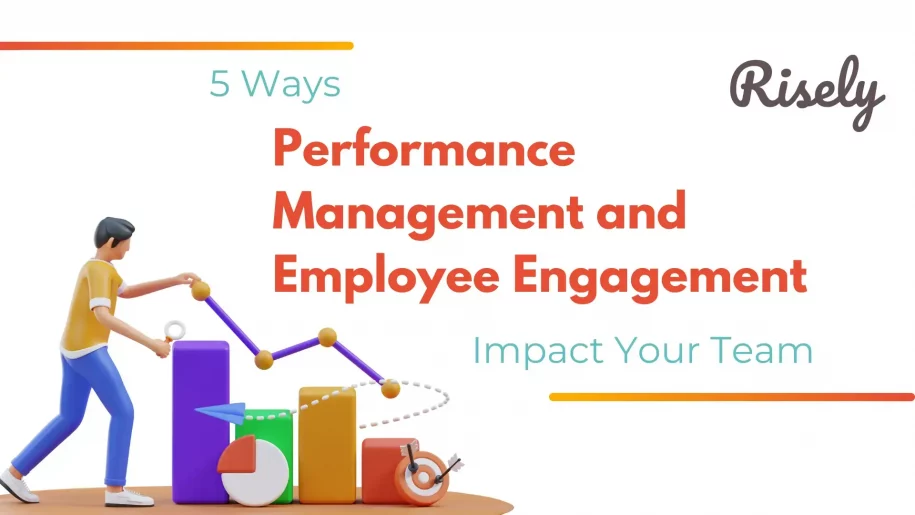5 Ways Performance Management and Employee Engagement Impact Your Team
Are you struggling to get the best out of your team? Are you facing employee absenteeism, decreased productivity, and low morale issues? Then, you need to focus on performance management and employee engagement. In this blog, we will explore how these two elements are linked and how they impact your team’s overall performance. We will delve deep into how poor employee engagement can affect performance management and vice versa. Moreover, we will discuss the benefits of effective employee engagement and performance management. We will also highlight strategies for integrating employee engagement and performance management, overcoming common challenges, and future trends. By the end of this blog, you will have a comprehensive understanding of creating a positive work environment using performance management and employee engagement that benefits your team’s productivity and effectiveness.- 5 Ways Performance Management and Employee Engagement Impact Your Team
- Understanding the Link between Performance Management and Employee Engagement
- The Benefits of Effective Employee Engagement and Performance Management
- Strategies for Integrating Employee Engagement and Performance Management
- Overcoming Common Challenges in Managing Performance and Engagement
- Future Trends in Employee Engagement and Performance Management
- Conclusion
- Other Related Blogs
Understanding the Link between Performance Management and Employee Engagement
Employee engagement and performance management are closely intertwined. Engaged employees positively impact performance management, contributing to higher levels of engagement. Effective performance management, on the other hand, enhances employee engagement. Understanding the connection between these two aspects is crucial as they are interrelated. When employees are engaged, they are more likely to put in their best efforts, leading to improved individual and overall business performance. Performance management, in the form of assessments and feedback-driven processes, provides a great way to identify and improve upon the strengths and motivations of employees. It creates an engaged workforce and fosters a sense of attachment to the organization. Recognizing and praising employees for their achievements reduces the fear of uncomfortable meetings or repercussions, further enhancing engagement. The positive impact of employment on performance is a clear link that leaders should harness to benefit their bottom line.The Impact of Poor Employee Engagement on Performance Management
Low employee engagement hurts performance management. When employees are disengaged, their performance reviews tend to be lower as they may lack motivation and productivity. This, in turn, hinders the overall success of the organization. Additionally, poor employee engagement often leads to higher turnover rates, which can disrupt team dynamics and create a loss of talent and institutional knowledge. Moreover, low engagement undermines the effectiveness of performance management practices such as regular feedback and performance assessments. To effectively manage performance, addressing and improving employee engagement is crucial, ensuring a more engaged and committed workforce.What Are the Consequences of Low Employee Engagement for Your Team?
- Decreased Productivity: Low employee engagement reduces productivity within your team. When employees are disengaged, they may lack motivation to perform at their best, resulting in lower output and decreased overall team efficiency. It ultimately impacts the team’s ability to meet its goals and objectives.
- Increased Turnover: Low employee engagement often correlates with higher turnover rates. When employees feel disconnected from their work or disenchanted with their roles, they are more likely to seek employment opportunities elsewhere. High turnover can disrupt team dynamics, increase recruitment and training costs, and lose valuable institutional knowledge.
- Poor Team Morale and Collaboration: Low employee engagement can negatively affect team morale and collaboration. Disengaged employees may be less likely to collaborate effectively, share ideas, or contribute to a positive team culture. It can lead to conflicts, decreased communication, and a generally less cohesive and effective team environment.
How Does Poor Performance Management Affect Employee Engagement?
Poor performance management can have many negative impacts on employee engagement:- Employees feel isolated: When employees do not receive the support needed to reach their potential through feedback and engaging in development conversations with their managers, they are likelier to feel isolated and misguided at work. As a result, they lack a sense of belongingness in the workplace.
- Low team morale: A minimalistic approach to performance shows employees that the team does not value their growth and development. Instead, the commitment is only toward achieving goals. In such cases, employee morale and motivation go down.
- Confusion in team members: Performance management sets the way for team members to go on a quest that concerns them and their careers. Without a performance management plan that constantly works to improve them, team members end up confused about their goals. Even in self-led efforts, they are likelier to face more hurdles and make mistakes that a manager’s support could have helped avoid.
The Benefits of Effective Employee Engagement and Performance Management
Effective employee engagement and performance management have numerous benefits for organizations. One key benefit is the development of high-performing teams. When engaged and motivated, employees are more likely to contribute their best efforts, improving individual and business performance. It enhances the bottom line and helps drive the organization toward its broader vision. Moreover, effective employee engagement and performance management lead to other positive outcomes. For example, employees’ well-being and satisfaction increase when they feel valued and supported. It creates an attachment and a sense of loyalty to the organization, contributing to long-term retention and reduced turnover rates. Additionally, an engaged workforce becomes a competitive advantage, as it attracts and retains top talent, setting the organization apart from others in the industry. In summary, effective employee engagement and performance management deliver a range of benefits, including high-performing teams, improved individual performance, enhanced employee well-being, increased employee loyalty, and a competitive edge in the market.How Can You Create a Positive Work Environment through Performance Management and Employee Engagement?
Creating a positive work environment through performance management and employee engagement involves:- Fostering open communication.
- Recognizing and praising employees regularly.
- Implementing mentorship programs.
- Conducting employee check-ins.
- Setting practical goals for performance reviews.
Strategies for Integrating Employee Engagement and Performance Management
To successfully integrate employee engagement and performance management, aligning employee engagement initiatives with the organization’s goals is crucial. By doing so, you ensure that employee engagement efforts directly contribute to the business’s overall success. Taking a holistic approach by combining employee engagement and performance management allows for a more comprehensive understanding of individual performance within the organization’s broader vision. Implementing HR practices prioritizing engagement and performance management helps create consistency in performance management and engagement practices, ensuring that the two are mutually reinforcing. Lastly, to measure the impact of employee engagement, it’s essential to use performance metrics that go beyond just the bottom line, considering the motivations of employees and their own goals. This feedback-driven approach allows for an engaged workforce and provides a clear positive link between engagement and business performance. To sum up, a few steps that managers can take to integrate employee engagement and performance management are:- Alignment with Organizational Goals: The team’s vision lies at the heart of performance management and employee engagement. The team’s vision statement can help managers decode the organization’s philosophy and values that bind the team together. On the other hand, it can also help understand what and how they want to achieve performance goals. Communicating this effectively to the team and getting them on board to take the mission forward is the first step in building these two critical processes together.
- Adopting a holistic approach: As we focus on two processes that share many variables, with the employee’s growth at the center stage, it is essential to find ways to complement each other. For instance, feedback loops can enhance engagement with direct reports and improve performance. Setting up such structures that bring the stakeholders on a shared platform is key.
- Quality or Quantity? Defining the focus: When managers track performance, it’s too easy to get caught up in fancy charts and numbers that measure everything. But, the key is to remember that version is not just about strategic objectives. In such instances, managers must redefine performance to make space for qualitative aspects such as knowledge sharing, engagement, mentoring peers, etc. Implement a balanced scorecard approach that includes financial, customer, internal process, and employee perspectives to measure overall organizational performance. Additionally, you can incorporate qualitative metrics, such as employee satisfaction scores, Net Promoter Scores, and retention rates, to gauge engagement’s impact on the workforce.
Overcoming Common Challenges in Managing Performance and Engagement
Addressing disengaged employees is essential to countering performance issues in teams. Hence, both the processes go hand in hand. Yet, some common challenges can derail them.- Poor communication or employee buy-in: It is crucial to promote open and transparent communication channels. Encouraging frequent two-way feedback and providing regular opportunities for employees to voice their ideas and opinions are also effective. Additionally, fostering a culture of trust and psychological safety and offering workplace training to enhance communication skills can help overcome these challenges.
- Handling difficult performance management conversations: Effective techniques for handling difficult conversations include approaching them with empathy and understanding, providing specific examples to support feedback and suggestions, focusing on solutions and development instead of blame and criticism, offering support and resources for improvement, and following up to ensure progress and accountability.
Future Trends in Employee Engagement and Performance Management
As organizations increasingly recognize the importance of employee engagement, future trends are emerging in performance management practices. One key trend is emphasizing employee well-being as a driver of engagement. Recognizing that a healthy and happy workforce is more likely to be engaged, businesses prioritize initiatives promoting physical, mental, and emotional well-being. Another trend is the incorporation of technology to enhance performance management processes. Utilizing tools such as data analytics, mobile apps, and online platforms, businesses can streamline and automate tasks, making performance management more efficient and effective. In addition, there is a shift towards holistic approaches considering both employee and business outcomes. It involves aligning individual performance goals with organizational objectives creating a sense of employee purpose and motivation. Data-driven strategies are also gaining prominence in measuring and improving engagement. By collecting and analyzing employee feedback and performance data, organizations can identify areas of strength and improvement, enabling them to tailor engagement initiatives accordingly. Finally, the future of employee engagement and performance management lies in continuous adaptation and evolution. Rather than relying on static practices, businesses are embracing a dynamic approach that allows for flexibility and responsiveness to changing needs and expectations.Conclusion
In conclusion, the link between performance management and employee engagement is crucial for the success and productivity of your team. When employees are engaged, they are more motivated, committed, and satisfied with their work, which ultimately leads to better performance. On the other hand, poor employee engagement can have negative consequences such as high turnover, low morale, and decreased productivity. By implementing customized programs and addressing challenges, you can ensure that your team thrives and adapts to future employee engagement and performance management trends.Sharpen your constructive feedback skills to ace as a team manager.
Test your constructive feedback skills for free now with Risely’s self-assessment.
Other Related Blogs
Assertive Feedback Techniques ft. Gurleen Baruah
Assertive Feedback Techniques ft. Gurleen Baruah Let’s be real—giving feedback as a manager isn’t always easy. Say too little, and nothing changes. Say too much, and it might come off…
How to ask for feedback from employees? | Gurleen Baruah
How to ask for feedback from employees? | Gurleen Baruah Feedback is a two way street. This podcast took managers on a trip down the other side. As managers, we…
Let’s Reverse the Gaze of Radical Candor?
Let’s Reverse the Gaze of Radical Candor? Have you heard about Radical Candor? It’s a book by Kim Scott that first came out in 2017. The tagline is “Caring Personally…
How To Become A Leadership Coach In 5 Steps
How To Become A Leadership Coach In 5 Steps Becoming a leadership coach is a fulfilling and rewarding career path for those who are passionate about helping others develop their…


